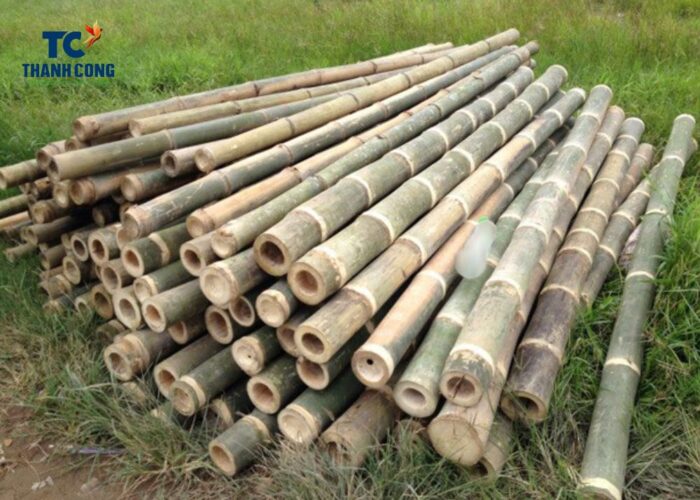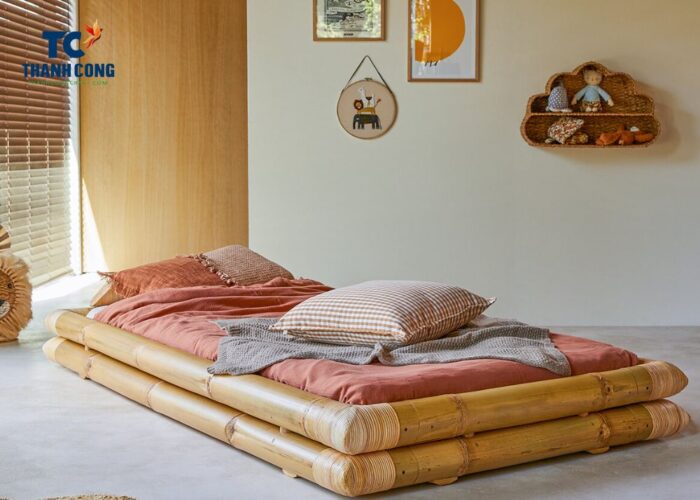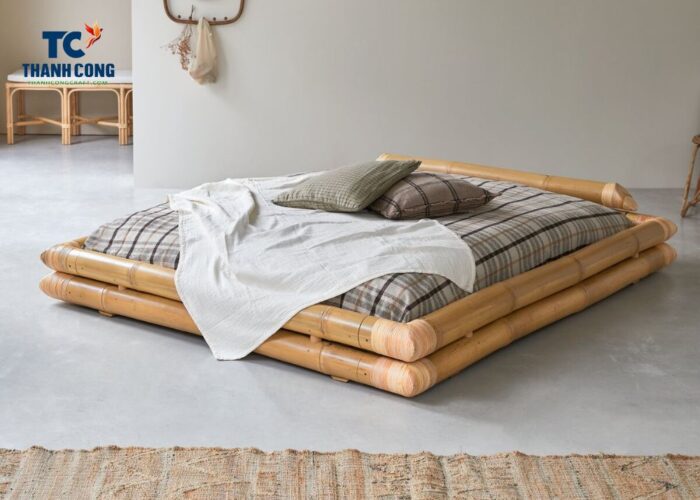A cozy, nature-inspired bamboo bed, designed with a contemporary touch, is an excellent choice. Providing a delightful retreat for you to return to each day, it beckons you to indulge in a restful sleep. Today, Thanh Cong Craft will guide you on how to make bamboo bed.
1. Bamboo Bed Materials
To make a bamboo bed design, you’ll need a set of materials to ensure a sturdy and aesthetically pleasing final product. Here’s a list of essential materials for crafting a bamboo bed:
- Bamboo Poles: Select sturdy and straight bamboo poles for the bed frame. The diameter and length will depend on the design and dimensions of your bed.
- Bamboo Plywood or Boards: They are the bamboo bed material components for making headboard, footboard, and sides. Bamboo plywood provides a smooth surface and structural support.
- Wood Glue: High-quality wood glue is essential for bonding bamboo pieces together securely.

- Clamps: Clamps are necessary for holding bamboo pieces in place while the glue dries, ensuring a strong bond.
- Screws: Use screws to reinforce joints and connections in the bamboo frame. Choose screws appropriate for woodworking and bamboo material.
- Drill: A drill is required for making holes in the bamboo pieces to accommodate screws.
- Sandpaper: Sandpaper of varying grits is useful for smoothing surfaces and refining the edges of bamboo pieces.
- Measuring Tape and Ruler: Accurate measurements are crucial for ensuring that your bamboo bed is well-proportioned and stable.
- Pencil or Marker: Use a pencil or marker to mark cutting lines, assembly points, and other details on the bamboo.
- Protective Gear: Wear safety glasses, gloves, and a dust mask when cutting, sanding, and handling bamboo to ensure safety.
Make sure to adapt the materials based on your specific bed design and size requirements. Additionally, consider using sustainably sourced bamboo to align with eco-friendly practices.
2. How to Make Bamboo Bed?
Step 1: Preparing Bamboo Segments for The Bamboo Bed Frame
The initial step in crafting a bamboo bed frame involves cutting the bamboo into equal-length segments, a pivotal phase determining the bed’s dimensions. Tailor the length of the segments according to your desired bamboo bunk width and length. Typically, cutting 8 to 12 bamboo segments for each dimension is recommended, providing sufficient material for a sturdy and balanced frame.
To execute this step meticulously, measure and mark the bamboo lengths using a measuring tape or ruler. Precision in these measurements is paramount to ensure uniformity in the bed frame’s construction. Once marked, employ a saw to make clean, even cuts along the segments. Careful attention to precision in cutting will contribute significantly to the overall success of your bamboo bed crafting endeavor.
Step 2: Creating Connective Grooves in Bamboo Segments
Moving on to the second critical step in crafting your bamboo bed, it’s time to enhance the interlocking capability of the segments. To achieve this, focus on one end of each bamboo segment, carefully splitting it into four parts. The purpose of this split is to fashion grooves that will facilitate a secure and seamless connection between the bamboo segments.

Utilize a saw to make clean and straight splits, extending them to a depth of approximately 10-15 cm. These grooves are instrumental in ensuring stability and durability in the overall frame construction. The depth of the split should be adequate to allow for a snug fit when the segments are joined together in subsequent steps.
Step 3: Assembling the Bamboo Bed Frame
In the third crucial step of crafting your bamboo bed, it’s time to bring together the segmented pieces to form the bed frame. This assembly involves both horizontal and vertical connections to establish a sturdy and well-integrated structure.
How to tie up bamboo, use a durable rope to tie the grooves of the bamboo segments together. This method allows for flexibility and easy disassembly if needed. Ensure the knots are secure to provide stability to the bed frame. Alternatively, you can use nails to hammer the segments into each other. This method provides a more permanent connection and adds to the bed’s overall robustness.
Step 4: Refining the Bed Frame Shape
Begin by carefully examining the corners of the frame, identifying any excess bamboo parts that may extend beyond the desired square or rectangular shape. Using a saw or cutting tool, trim off the surplus bamboo at each corner. This process is essential to achieve a clean and well-defined frame shape, ensuring symmetry and an aesthetically pleasing appearance.
Additionally, if you’ve used rope for securing the bamboo segments, inspect for any excess strands protruding from knots. Trim these with scissors to create a neat and streamlined finish. This step not only contributes to the visual appeal of your bamboo bed but also ensures that the frame fits seamlessly within the intended dimensions of your mattress.
Step 5: Ensuring Bed Frame Alignment
Placing the frame on a flat surface, meticulously inspect its positioning and assess whether it appears skewed or not. If misalignment is detected, adjustments can be made to rectify it.

For frames secured with rope, you can fine-tune the alignment by tightening or loosening the rope strands at strategic points. This allows for incremental adjustments to achieve a level and balanced frame. A well-aligned bed frame not only enhances the aesthetics but also ensures comfort and longevity as you proceed to complete your bamboo bed project.
Step 6: Completing the Bamboo Bed
With the bamboo bed frame successfully aligned, the next step involves bringing comfort and style to your creation. Place a mattress atop the bed frame, choosing a type that aligns with your comfort preferences and sleep requirements. Whether it’s a memory foam, latex, or traditional spring mattress, the choice is yours.
After positioning the mattress, enhance the visual appeal and comfort by spreading a bed sheet over it. This step allows for personalization, and you can select a bed sheet that complements the overall design and aesthetic you envision for your bamboo bed.
By completing Step 6, your bamboo bed is now ready for use, combining the natural charm of bamboo with the cozy allure of a well-dressed bed.
In conclusion, the process of learning how to make bamboo bed offers not just a practical accomplishment but a personalized expression of creativity and sustainability. From the initial step of cutting and segmenting bamboo to the final touch of dressing the bed with a carefully chosen mattress and sheet, each stage contributes to the creation of a unique and eco-friendly sleeping space.
If you have any further questions, don’t hesitate to send thanhcongcraft an email us at info@thanhcongcraft.com or message us at WhatsApp: +84967485411. Hope to serve you soon! Best regard!












